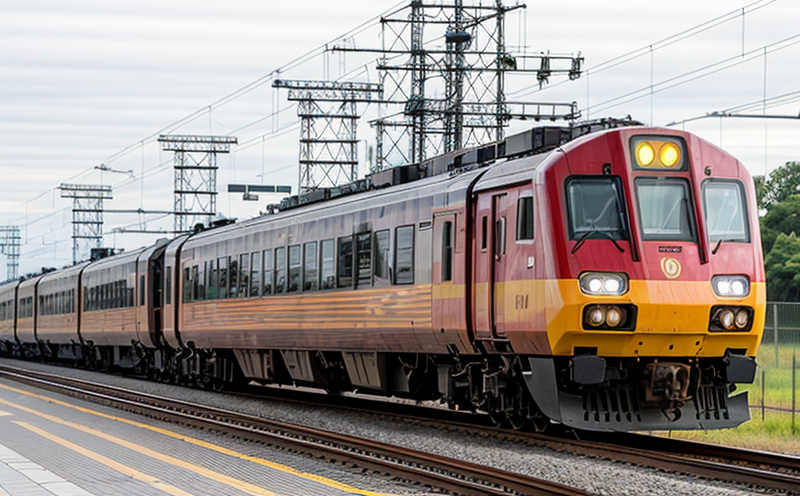EN 50155 Shock and Vibration Testing of Communication Electronics
The European standard EN 50155 provides a framework for testing railway communication electronics to ensure they can withstand the harsh operating environments found in railways. This service focuses on the specific requirements laid out by EN 50155 Clause 7: Mechanical Stress Testing (Shock and Vibration), which is critical for ensuring that communication systems are reliable, safe, and functional under extreme conditions.
The railway sector operates in environments characterized by dynamic and sometimes unpredictable forces. These include shock from train accelerations and decelerations, vibrations caused by track irregularities, and the potential for impacts due to external factors such as collisions or accidents. Communication electronics within this environment must be robust enough to maintain functionality under these stresses.
The testing process under EN 50155 aims to mimic real-world conditions, providing a standardized approach to evaluate how well communication devices can withstand mechanical stress without degradation in performance. This ensures that the equipment installed in railway vehicles meets the highest quality and reliability standards, which is essential for public safety and operational efficiency.
The test setup involves subjecting specimens (communication electronics) to controlled shock and vibration conditions using specialized testing machines. The standard specifies a range of test parameters including frequency response, amplitude levels, duration, and repetition rates that are designed to replicate the environmental stresses encountered in railway operation.
Following the tests, detailed reports are generated outlining the results of each specimen’s performance under various stress conditions. These reports are crucial for quality managers, compliance officers, R&D engineers, and procurement teams who need assurance that their products meet or exceed regulatory standards.
The testing process also helps in identifying potential weaknesses in design or manufacturing processes early on, allowing for improvements before the equipment is deployed in real-world scenarios. This proactive approach not only enhances product reliability but also reduces the risk of field failures, which could lead to costly downtime and safety issues.
Real-World Applications: The results from EN 50155 testing are particularly valuable for railway manufacturers who need to ensure their communication systems can operate reliably in challenging environments. By adhering to this standard, companies demonstrate a commitment to quality and compliance, which is essential for gaining and maintaining market share.
Why It Matters
The importance of EN 50155 shock and vibration testing cannot be overstated in the context of railway communication systems. Railway vehicles operate in an environment that exposes them to continuous mechanical stress, which can vary widely depending on factors such as speed, track conditions, and external impacts. Ensuring that communication electronics are robust enough to withstand these stresses is crucial for several reasons:
- Safety: Failure of communication systems in critical situations could lead to accidents with severe consequences.
- Reliability: Reliable communication ensures smooth operations, reducing delays and enhancing the overall efficiency of railway services.
- Compliance: Meeting regulatory standards like EN 50155 is essential for market access and compliance with international norms.
The testing process not only helps in identifying potential issues but also provides insights into how different design choices affect the performance of communication systems under mechanical stress. This information can be used to improve future generations of products, ensuring they are even more resilient against environmental challenges.
By investing in comprehensive shock and vibration testing, railway operators and manufacturers can build trust with customers and stakeholders, demonstrating a commitment to excellence and safety. This proactive approach also helps in reducing maintenance costs by identifying problems early on, thereby extending the lifespan of communication systems.
Applied Standards
| Standard | Description |
|---|---|
| EN 50155 Clause 7: Mechanical Stress Testing (Shock and Vibration) | This clause specifies the test methods for evaluating communication electronics in railway vehicles, including shock and vibration tests to ensure they can withstand mechanical stress. |
The testing process outlined in EN 50155 Clause 7 is designed to simulate real-world conditions that communication electronics might encounter during operation. The standard covers various aspects of mechanical stress, such as shock levels and vibration frequency ranges, which are critical for assessing the durability and reliability of these systems.
By adhering to this standard, manufacturers can ensure that their products meet the highest quality and reliability standards, thereby enhancing public safety and operational efficiency. This standardized approach also facilitates easier compliance with international regulations, making it easier for railway operators to deploy equipment across different regions.
Quality and Reliability Assurance
- Test Parameters: Frequency response, amplitude levels, duration, repetition rates.
- Instrumentation: High-precision shock and vibration testing machines capable of replicating real-world conditions.
- Acceptance Criteria: Specimens must pass all test parameters without degradation in performance to be considered compliant with EN 50155 standards.
The quality and reliability assurance process for EN 50155 shock and vibration testing involves a series of rigorous tests designed to evaluate the mechanical robustness of communication electronics. The primary goal is to ensure that these devices can perform reliably under extreme conditions, thereby enhancing public safety and operational efficiency.
Testing parameters such as frequency response, amplitude levels, duration, and repetition rates are critical for replicating real-world stress conditions accurately. High-precision shock and vibration testing machines are used to subject specimens to controlled environments that closely mimic the stresses they would encounter in railway operations.
The acceptance criteria stipulated by EN 50155 ensure that only products meeting or exceeding these standards can be considered compliant. Specimens must pass all test parameters without any degradation in performance to meet these stringent requirements. This process not only enhances product reliability but also helps in identifying potential weaknesses early on, allowing for improvements before deployment.
The comprehensive nature of this testing ensures that communication systems are robust enough to operate reliably under the dynamic conditions found in railway operations. By adhering to EN 50155 standards, manufacturers can demonstrate a commitment to quality and compliance, which is essential for gaining and maintaining market share.





